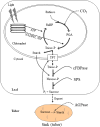Improving Potato Stress Tolerance and Tuber Yield Under a Climate Change Scenario - A Current Overview
- PMID: 31139199
- PMCID: PMC6527881
- DOI: 10.3389/fpls.2019.00563
Improving Potato Stress Tolerance and Tuber Yield Under a Climate Change Scenario - A Current Overview
Abstract
Global climate change in the form of extreme heat and drought poses a major challenge to sustainable crop production by negatively affecting plant performance and crop yield. Such negative impact on crop yield is likely to be aggravated in future because continued greenhouse gas emissions will cause further rise in temperature leading to increased evapo-transpiration and drought severity, soil salinity as well as insect and disease threats. This has raised a major challenge for plant scientists on securing global food demand, which urges an immediate need to enhance the current yield of major food crops by two-fold to feed the increasing population. As a fourth major food crop, enhancing potato productivity is important for food security of an increasing population. However, potato plant is highly prone to high temperature, drought, soil salinity, as well as insect and diseases. In order to maintain a sustainable potato production, we must adapt our cultivation practices and develop stress tolerant potato cultivars that are appropriately engineered for changing environment. Yet the lack of data on the underlying mechanisms of potato plant resistance to abiotic and biotic stress and the ability to predict future outcomes constitutes a major knowledge gap. It is a challenge for plant scientists to pinpoint means of improving tuber yield under increasing CO2, high temperature and drought stress including the changing patterns of pest and pathogen infestations. Understanding stress-related physiological, biochemical and molecular processes is crucial to develop screening procedures for selecting crop cultivars that can better adapt to changing growth conditions. Elucidation of such mechanism may offer new insights into the identification of specific characteristics that may be useful in breeding new cultivars aimed at maintaining or even enhancing potato yield under changing climate. This paper discusses the recent progress on the mechanism by which potato plants initially sense the changes in their surrounding CO2, temperature, water status, soil salinity and consequently respond to these changes at the molecular, biochemical and physiological levels. We suggest that future research needs to be concentrated on the identification and characterization of signaling molecules and target genes regulating stress tolerance and crop yield potential.
Keywords: drought; high CO2; high temperature; photosynthetic yield potential; potato; salinity; stress tolerance; yield.
Figures


References
-
- Ahn Y. J., Claussen K., Zimmerman J. L. (2004). Genotypic differences in the heat-shock response and thermotolerance in four potato cultivars. Plant Sci. 166 4901–4911.
-
- Akhtar S. S., Anderson M. N., Liu F. (2015). Biochar mitigates salinity stress in potato. J. Agron. Crop Sci. 201 368–378. 10.1111/jac.12132 - DOI
Publication types
LinkOut - more resources
Full Text Sources
Research Materials
Miscellaneous

